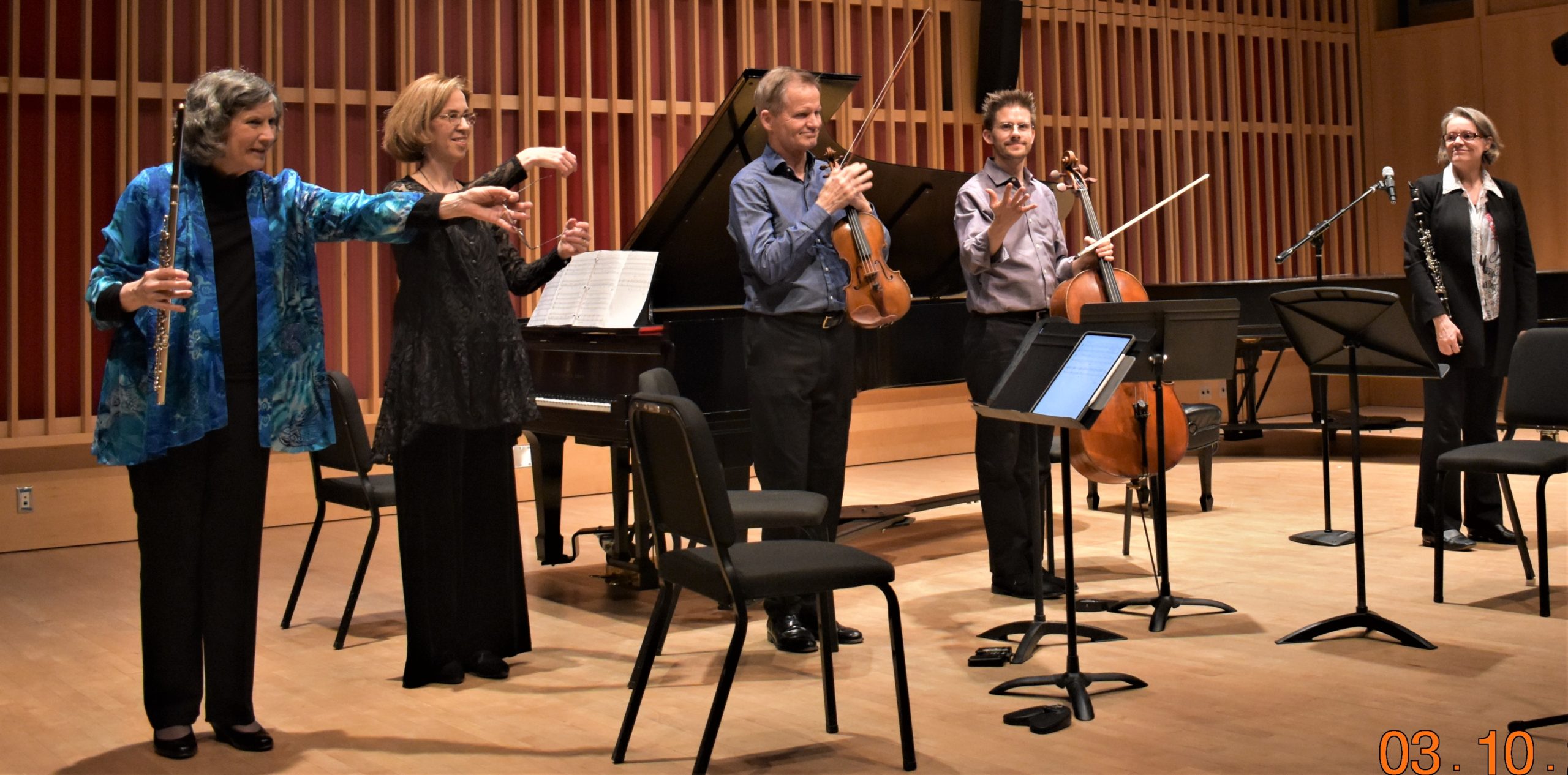Da Capo Chamber players last Tuesday night, March 10, at the Lászlo Z. Bitó Conservatory Building, provided a program titled CELEBRATE BARD! All the works performed were by Bard Faculty or graduates.
They opened with Foreshadowed Flashback (2017) by pianist and composer Corey Chang (b. 1996) who graduated from Bard last year. This composition was unusual, mysterious in low register with Marianne Gythfeldt’s bass clarinet contributing the principal timbre of the ensemble piece. Its tripartite structure (slow, fast, slow) was Otherworldly, sometimes ethereal, yet predominantly infused with an Underworld landscape that freighted taut suspense, which kept the audience on the edge of their seats. I’ve heard some of Chang’s work before; I believe he is a major contemporary composer, maybe even the major composer of his generation. Although piano notes were spare, they were haunting at the fingertips of Margaret Kampmeier, who evoked a daemonic affirmation in higher register. This work continues to tickle my imagination.
Curtis Macomber, the leader of the ensemble, next played String Force (2010) by Bard Faculty member Joan Tower. This solo virtuoso work rushes to the edge of silence with fillips of impish trills as if it’s going up dead alleyways where a claustrophobic madness descends and there appears to be no escape until a saving ray of light offers an illuminated release, something akin to Samuel Beckett’s plight: “ I can’t go on. I’ll go on.” The ferocity of Macomber’s performance was arresting, hypnotic. This work is exhausting and demanding. The concluding sudden reversal of being freed from imprisonment or suffocation is fiercely cathartic.
Pixeliance (2011/2017) by Peri Mauer (b. 1954) presented a one-movement dance for flute, harp, and marimba. Patricia Spencer’s flute dominated the dance steps while Jon Clancy’s percussion grounded the rhythm as Sara Cutler’s plucking at harp delivered a spiritual dimension to the dance.
Hovenweep (2000) by Kyle Gann (b. 1955) was inspired by the ruins of a native Anasazi city that existed between 500 BC and its apparent demise around 1300 AD. This elegy for the vanished past employs elements of Hopi, Zuni and Pueblo music performed by a five-piece ensemble. Chris Gross on cello laid the stone foundation for piano, violin, flute, and clarinet.
In Distance by Tan Dun (b. 1957) was a minimalist composition with roots in allegory as well as the meditative suspense one often encounters in the work of John Cage, but structure was more taut, propulsive. Spencer played the flute as if it were a pipa, the short flute beloved by the common folk. Spenser played with inspired ferocity in opposition to the authoritative kettle drum of Jon Clancy. These two instruments appeared to debate and disagree. Clancy was masterful in the long drum solo that appeared to rebuke the upstart pipa. Sara Cutler’s harp sounded the memory of varied Chinese traditions of ethics and philosophy that both drum and pipa appeared to be deaf to. There was tragedy in the role of the harp, which evoked the greatness of a lost culture of refinement. Although there were only three instruments, I found this work to be spellbinding: both simple and sophisticated, while registering high energy.
A Free People (2006) by John Halle (b. 1959) was obviously inspired by Aaron Copland’s Lincoln Portrait (1942). Halle narrated a text about the gradual rise of autocratic fascism in Germany with a trio of violin, cello, and piano. Here was implied allegory about 9/11 and the Iraq War as instrumenta of institutional and cultural change. Halle’s clear diction was supported and highlighted by the trio. This kind of composition remains difficult to succeed with: difficult to remain clear, difficult to sustain suspense, difficult to both be clear and meld with the music. But Halle did all that and perhaps more.
From these two high peaks, one must see the view from the mountain. That view, mellow, tender, evocative, and exquisitely poetic, was provided by Elizabeth Brown (b. 1953), who, to my surprise, was seated just behind me. Liguria (1999) offered an essay-like mediation on the landscape of Genoa. This climatic masterpiece by the Da Capo quintet captured the arc of a day and night as well as the generational ambiance of life that includes the play of children, work of farmers, and reflections on life by contemplative elders. The landscape of olive trees and scudding clouds gives way to the glow of sunset, brooding twilight, and the languid dreams of a pleasant nightscape, a lost Edenic world that humankind has neglectfully abandoned. There was such poignancy in the elegiac conclusion that I felt like a candle being snuffed out, yet still smelling the scent of wax as I envisioned various vistas–so astonished that I felt that clapping for this lyrical marvel was uncouth behavior.
